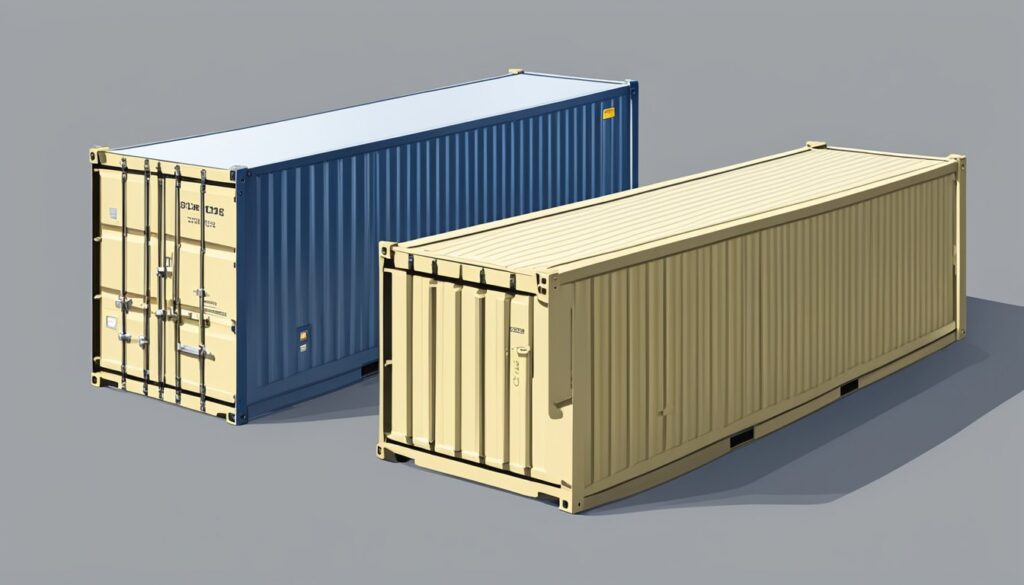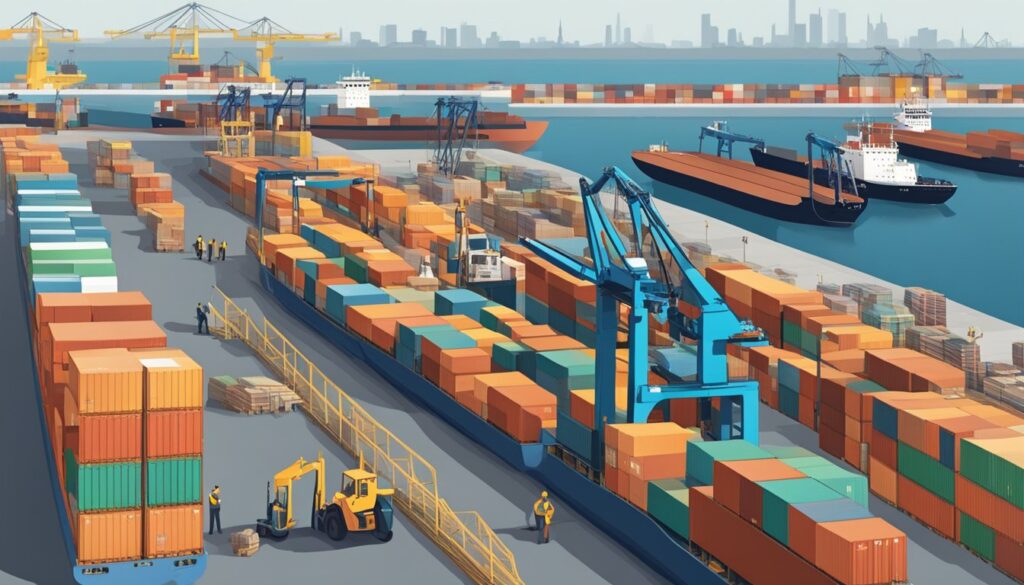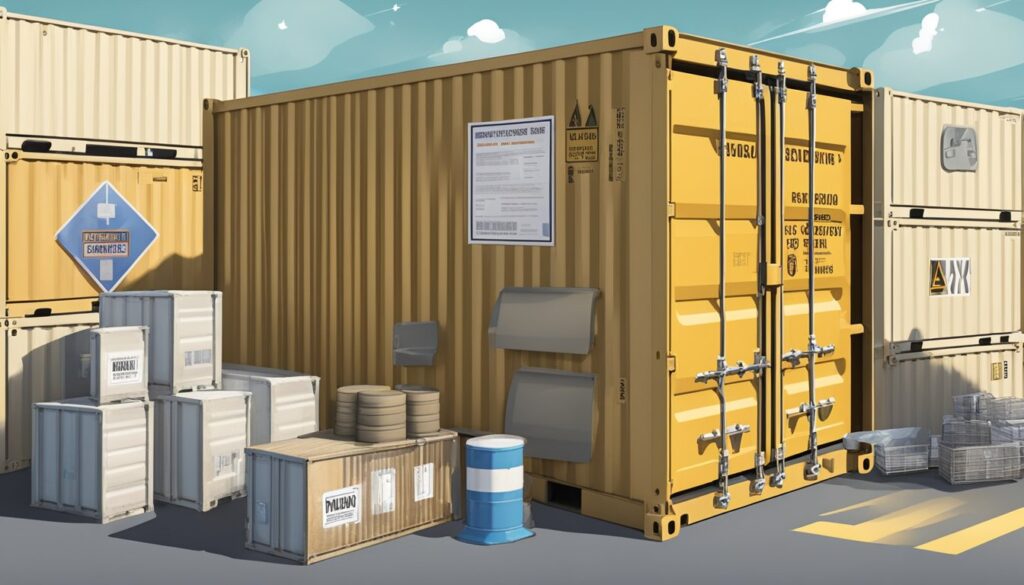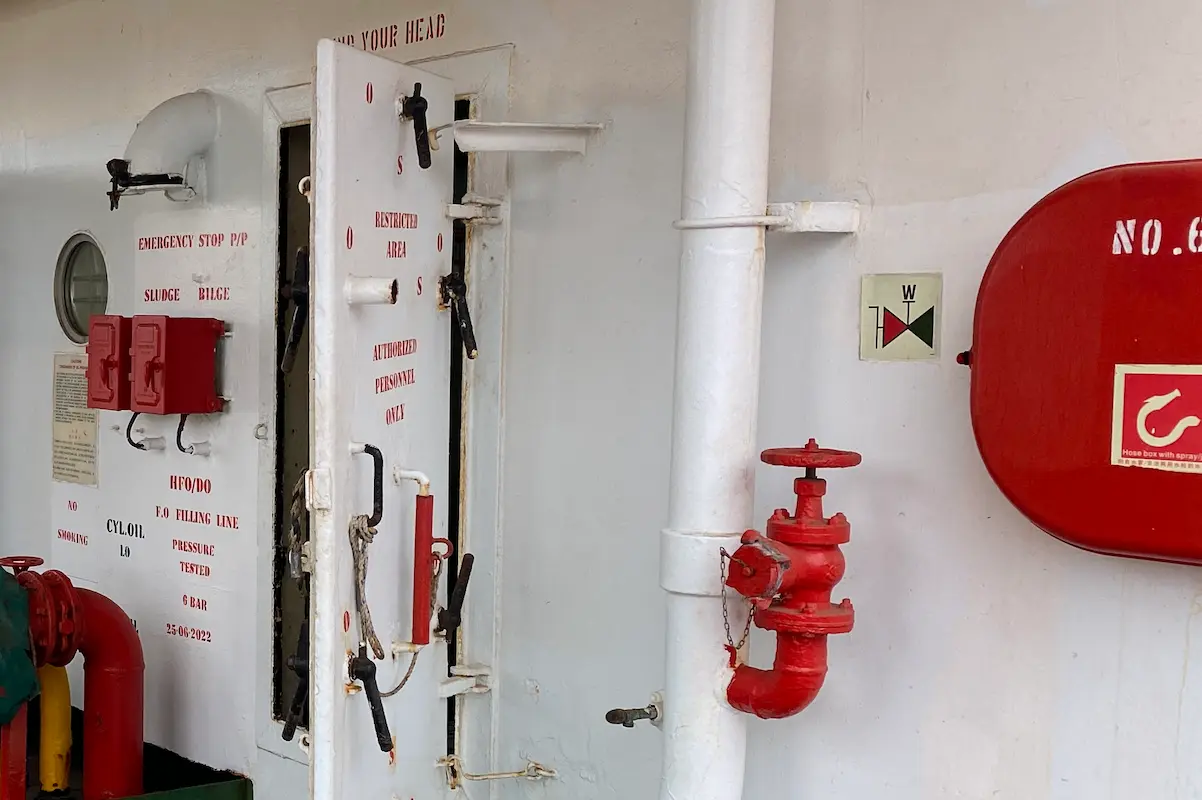Loss control prevention in shipping is an essential aspect of supply chain management. Losses can occur due to a variety of reasons such as theft, damage, spoilage, and mishandling.
Loss control prevention is the process of implementing strategies and measures to reduce or eliminate various types of losses that can occur during various stages of the supply chain, including the transportation, storage, and distribution of goods.

To prevent losses, shippers must apply adequate packing or packaging to ensure that the goods reach their destination safely. Containers or boxes should be large enough to allow room for adequate cushioning material on all sides of the contents.
The packaging should be suitable for the contents, and the maximum gross weight of the container should not be exceeded. Plastic pallets are one tool for reducing product losses that can be easily implemented within a supply chain without much disruption to daily business operations. They are tougher than the wood pallets common in most supply chains, which reduces the amount of product lost due to platform breakage.
Effective loss control prevention in shipping requires a comprehensive approach that involves identifying potential risks, implementing preventive measures, and monitoring the process to ensure that it is effective.
It is crucial to work with a reliable logistics partner who understands the importance of loss control and has the necessary expertise and resources to implement effective loss control measures. By taking a proactive approach to loss control prevention, shippers can reduce the risk of losses, minimize costs, and improve the overall efficiency of their supply chain.
Understanding Loss Control Prevention

Loss control prevention is the practice of minimizing the risk of loss or damage to goods during the shipping process. It involves a combination of strategies, techniques, and best practices that aim to prevent losses caused by theft, damage, or human error.
The goal of loss control prevention is to ensure that goods arrive at their destination safely and in good condition. This is important for both the shipper and the receiver, as losses can result in financial losses, reputational damage, and even legal liability.
Some of the key strategies and techniques used in loss control prevention include:
- Proper packing and labeling of goods to ensure that they are handled and transported safely.
- Use of tamper-evident seals and locks to deter theft and ensure that goods are not tampered with during transit.
- Implementation of strict inventory control procedures to ensure that goods are properly accounted for at all times.
- Regular inspections of shipping facilities and equipment to identify potential hazards and address them before they cause problems.
- Training of shipping personnel on proper handling and transportation procedures to minimize the risk of damage or loss.
By implementing these strategies and techniques, shippers can significantly reduce the risk of losses during the shipping process. This can help them save money, protect their reputation, and ensure that their customers are satisfied with the quality of their products.
Importance of Loss Control Prevention in Shipping
In the shipping industry, loss control prevention is a vital component of an integrated logistics program. It aims to minimize the risks and prevent losses due to a variety of factors such as theft, damage, accidents, and natural disasters. By implementing effective loss control prevention measures, shippers can reduce the likelihood of losses, protect their cargo, and ensure the safety of their employees.
One of the main reasons why loss control prevention is important in shipping is because of the high value of cargo being transported. The cost of shipping can make up a significant portion of the overall product cost, and a single loss or damage can result in significant financial losses. By implementing loss control measures such as proper packaging, securing cargo, and using the right equipment, shippers can minimize the risks of damage and loss.
In addition to financial losses, shipping losses can also result in safety hazards and liability issues. Accidents and collisions can cause injuries or fatalities to employees and other parties involved, resulting in costly legal battles and compensation claims. By implementing proper safety measures and risk management strategies, shippers can reduce the likelihood of accidents and minimize the severity of the damages.
Effective loss control prevention also involves the use of technology and data analysis to identify potential risks and prevent losses. By utilizing tools such as automatic identification systems (AIS) and claims data analysis, shippers can monitor their cargo and identify potential risks before they occur. This can help them make informed decisions and take proactive measures to prevent losses.
Overall, loss control prevention is a critical aspect of shipping operations. By implementing effective loss control measures, shippers can minimize the risks of damage, loss, and liability, and ensure the safety of their employees and cargo. This can also help them reduce their insurance premiums and improve their supply chain security, making them more competitive in the market.
Components of Loss Control Prevention

Loss control prevention in shipping is an essential process that helps businesses to minimize the risk of damage and loss of assets and revenue. The following are the key components of loss control prevention:
Risk Management
Risk management is a critical component of loss control prevention in shipping. It involves identifying potential risks and developing strategies to mitigate them. Businesses must conduct regular risk assessments to identify potential hazards and take appropriate measures to prevent them. Risk management also involves monitoring and evaluating the effectiveness of the strategies implemented.
Safety Measures
Safety measures are crucial in preventing losses in shipping. Businesses should implement safety procedures that comply with industry standards and regulations. These measures include providing adequate training to employees, ensuring proper handling of cargo, and maintaining a safe working environment. Regular safety inspections and audits should also be conducted to ensure that safety measures are being followed.
Cargo Packaging and Handling
Proper cargo packaging and handling are critical components of loss control prevention in shipping. Businesses should follow best practices for packaging and handling to prevent damages during transit. This includes using appropriate packaging materials, securing cargo properly, and ensuring that cargo is handled with care.
Technology and Data Analysis
Technology and data analysis play an essential role in loss control prevention in shipping. Businesses can use technology to track and monitor shipments, identify potential risks, and implement preventative measures. Data analysis can also help businesses identify patterns and trends that may lead to losses and take appropriate measures to prevent them.
In conclusion, loss control prevention in shipping is a complex process that involves multiple components. By implementing the above components, businesses can minimize the risk of damage and loss of assets and revenue.
Challenges in Implementing Loss Control Prevention
Operational Hurdles
One of the biggest challenges in implementing loss control prevention in shipping is the operational hurdles that arise due to the complexity of the shipping process. Shipping involves multiple parties, including shippers, carriers, and receivers, and each party has its own set of responsibilities. As a result, it can be difficult to ensure that everyone is following the proper procedures to prevent loss.
To address this challenge, it is important to establish clear guidelines and procedures for all parties involved in the shipping process. This includes providing training and education on loss control prevention and ensuring that everyone is aware of their responsibilities. Additionally, regular communication and collaboration between all parties can help to identify potential issues and prevent them from becoming major problems.
Technological Limitations
Another challenge in implementing loss control prevention in shipping is the technological limitations that exist in the industry. Many shipping companies still rely on manual processes and outdated technology, which can make it difficult to track shipments and identify potential issues.
To overcome this challenge, it is important to invest in modern technology and tools that can help to automate the shipping process and provide real-time visibility into shipments. This includes using inventory management software to track shipments and identify potential issues, as well as investing in sensors and other technologies that can help to monitor cargo and prevent loss.
Regulatory Constraints
Finally, regulatory constraints can also pose a challenge to implementing loss control prevention in shipping. Different countries have different regulations and requirements for shipping, which can make it difficult to establish consistent procedures for preventing loss.
To address this challenge, it is important to stay up-to-date with the latest regulations and requirements in each country where shipping is conducted. This includes working closely with regulatory agencies and industry groups to ensure that all parties are aware of the latest regulations and that procedures are in place to comply with them. Additionally, regular training and education can help to ensure that everyone is aware of their responsibilities and is following the proper procedures to prevent loss.
Case Studies of Loss Control Prevention in Shipping
Loss control prevention is a crucial aspect of shipping operations that helps to minimize losses and maximize profits. Here are some case studies that demonstrate the importance of loss control prevention in shipping:
Case Study 1: Maersk Line
Maersk Line, the world’s largest container shipping company, has implemented various loss control measures to reduce cargo damage and loss. For example, the company uses specialized software to monitor the temperature and humidity of its containers, which helps to prevent damage to sensitive cargo such as pharmaceuticals and food products. Maersk Line also conducts regular inspections of its vessels and containers to ensure that they are in good condition and comply with safety regulations.
Case Study 2: CMA CGM
CMA CGM, a French container shipping company, has implemented a loss control program called “Safety First” to reduce accidents and injuries. The program includes regular safety training for employees, the use of safety equipment such as helmets and gloves, and the implementation of safety protocols for handling hazardous materials. As a result of these measures, CMA CGM has reduced its accident rate by 50% over the past five years.
Case Study 3: MSC
MSC, a Swiss-based container shipping company, has implemented a loss control program called “Cargo Care” to reduce cargo damage and loss. The program includes the use of specialized equipment such as airbags and straps to secure cargo, the monitoring of container conditions during transit, and the implementation of strict protocols for handling and loading cargo. As a result of these measures, MSC has reduced its cargo damage and loss rates by 30% over the past five years.
These case studies demonstrate that loss control prevention is a critical aspect of shipping operations that can help to reduce losses, improve safety, and increase profitability. By implementing loss control measures such as regular inspections, safety training, and specialized equipment, shipping companies can minimize the risk of accidents, injuries, and cargo damage, and ensure that their operations run smoothly and efficiently.
Future of Loss Control Prevention in Shipping
As the shipping industry continues to evolve and adapt to new challenges, the future of loss control prevention in shipping looks promising. With advancements in technology, regulations, and risk management systems, the industry is poised to reduce the frequency and severity of shipping losses.
One area of focus for the future of loss control prevention in shipping is the use of predictive analytics. By analyzing data from previous incidents and near-misses, shipping companies can identify potential risks and take proactive measures to prevent them from occurring. This includes investing in better training for crew members, improving maintenance schedules for vessels, and implementing stricter safety protocols.
Another key aspect of loss control prevention in shipping is the use of automation. By automating certain tasks and processes, shipping companies can reduce the risk of human error and improve overall safety. For example, automated cargo handling systems can reduce the risk of accidents and injuries during loading and unloading operations.
In addition, the industry is exploring new ways to improve communication and collaboration between shipping companies, regulatory bodies, and other stakeholders. This includes sharing best practices, developing common standards and guidelines, and working together to address emerging risks and challenges.
Overall, the future of loss control prevention in shipping looks bright. By leveraging technology, automation, and collaboration, the industry can continue to improve safety and reduce the risk of shipping losses.
Frequently Asked Questions
Why is loss control prevention important in shipping?
Loss control prevention is important in shipping because it helps to reduce the risk of damage, loss, and claims during the shipping process. Shipping companies face several challenges when transporting goods, including theft, damage, and delays. By implementing loss control prevention measures, companies can minimize these risks and ensure that their goods arrive at their destination safely and on time.
What are the strategies for loss control prevention in shipping?
There are several strategies for loss control prevention in shipping, including proper packaging, using tracking technologies, conducting regular inspections, and implementing security measures. Proper packaging involves using appropriate materials and techniques to protect goods during transit. Tracking technologies, such as GPS and RFID, can help companies monitor the location and condition of their goods in real-time. Regular inspections help identify potential issues early, while security measures, such as locks and alarms, can deter theft and unauthorized access.
How does loss control prevention benefit the shipping industry?
Loss control prevention benefits the shipping industry by reducing the risk of damage, loss, and claims, which can lead to cost savings and improved customer satisfaction. By implementing effective loss control prevention measures, shipping companies can minimize the risk of delays and disruptions, which can lead to increased efficiency and productivity.
What are the common causes of loss in shipping?
The common causes of loss in shipping include theft, damage, and delays. Theft can occur during transit or while goods are in storage. Damage can occur due to improper packaging or handling, while delays can be caused by a variety of factors, including weather, traffic, and mechanical issues.
What are the consequences of not implementing loss control prevention in shipping?
The consequences of not implementing loss control prevention in shipping can be severe, including lost revenue, damaged reputation, and legal liability. Shipping companies that fail to implement effective loss control prevention measures may face costly claims and lawsuits, which can result in financial losses and damage to their reputation.
What are the best practices for loss control prevention in the shipping industry?
The best practices for loss control prevention in the shipping industry include proper packaging, using tracking technologies, conducting regular inspections, and implementing security measures. Shipping companies should also develop and implement comprehensive loss control prevention policies and procedures, train employees on these policies and procedures, and regularly review and update them to ensure their effectiveness.
- 11 Boat Salvage Yards in Texas – January 18, 2025
- 7 Boat Salvage Yards in Michigan – January 15, 2025
- Fire Hose SOLAS Requirements, Regulation 10: Ensuring Maritime Safety – January 9, 2025



